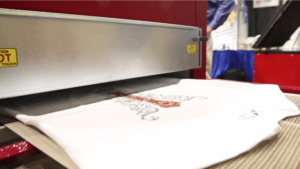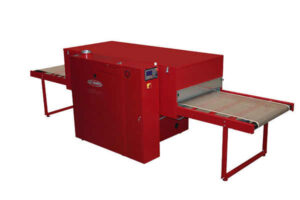

Revolutionizing the screen printing industry through cutting-edge technology and quality service
Anatol Equipment Manufacturing Co.
1429 S Shields Dr
Waukegan, IL 60085


Revolutionizing the screen printing industry through cutting-edge technology and quality service
Anatol Equipment Manufacturing Co.
1429 S Shields Dr
Waukegan, IL 60085

The difference between plastisol ink and water-based ink is especially evident when it comes to curing. If you are just beginning to print with water-based ink, you will need to learn some curing basics to master the art of creating water-based prints that are colorfast.
With plastisol inks, curing only requires bringing the ink to the manufacturer’s recommended temperature for a few seconds, which allows the PVC particles and the plasticizer in the ink to bond together and hold tightly to your substrate. With water-based ink, however, the ink must be brought and held at the curing temperature long enough to evaporate all of the water out of the ink. Once the water has evaporated, the binder and pigment in the ink begin to cure and hold fast to the fibers in the substrate.
As with any ink, proper curing involves following the ink manufacturer’s recommendations. When curing most water-based inks, that means heating the print to 300 to 320 degrees Fahrenheit for 2 to 3 minutes.
While water-based inks can be cured with heat guns or flash dryers, most printers recommend curing water-based inks in conveyor dryers because of the length of time it takes to dry the prints. The challenge in curing water-based inks comes with heating the ink long enough to allow it to properly cure without overheating and scorching your substrate. Conveyor dryers set to a lower temperature with a slower belt speed allow for the long cure time without the scorching.

You’ll want to reach a cure temperature of 300 to 320 degree for the 2 to 3 minutes required for curing water-based ink, so set the conveyor dryer to a temperature between 550 and 600 degrees and lower the belt speed. As with curing plastisol inks, you can use temperature strips or an infrared thermometer to check the temperature of the ink as it comes off of the dryer. You also will want to perform a wash test of a trial print to be sure that your water-based ink has been properly cured.
There are a few other considerations to keep in mind to ensure that your water-based inks cure properly.
First, be sure that you are not applying too much ink to your substrates. Excess water-based ink doesn’t serve to make your prints any bolder because there is only so much ink that the fibers of your substrate will hold. In addition to leading to wasted ink and money, over applying water-based ink can lead to much longer cure times because of the amount of water that will have to be evaporated from the ink. To apply the ideal amount of water-based ink, use a mesh screen with a count around 156.
Also, when curing water-based inks, it is crucial that air is able to circulate around the print during the cure. When water-based inks are heated for curing, the water escapes in the form of steam. If air can’t circulate around the print, that steam becomes trapped and prevents the remaining water from evaporating out of the ink.

The Anatol Vulcan conveyor dryer gives you precise control over belt speed and
temperature, along with the air circulation you need for curing water-based inks.
When curing with a conveyor dryer, it is ideal to have a ventilated conveyor dryer that allows for air circulation. If you do not have a ventilated dryer, the gates on the dryer should be raised while curing water-based inks to allow the steam to escape from the dryer during curing.
Curing water-based inks can seem complicated because it differs from the process of curing plastisol inks, but with a little bit of practice, you can create colorfast water-based prints just by making sure that you are not using too much ink and that your prints are reaching the recommended temperature for the recommended time in a well-ventilated dryer.
Looking for the right dryer to handle all of your curing requirements? Let’s talk about finding the right solutions for you!
Your message was successfully sent!